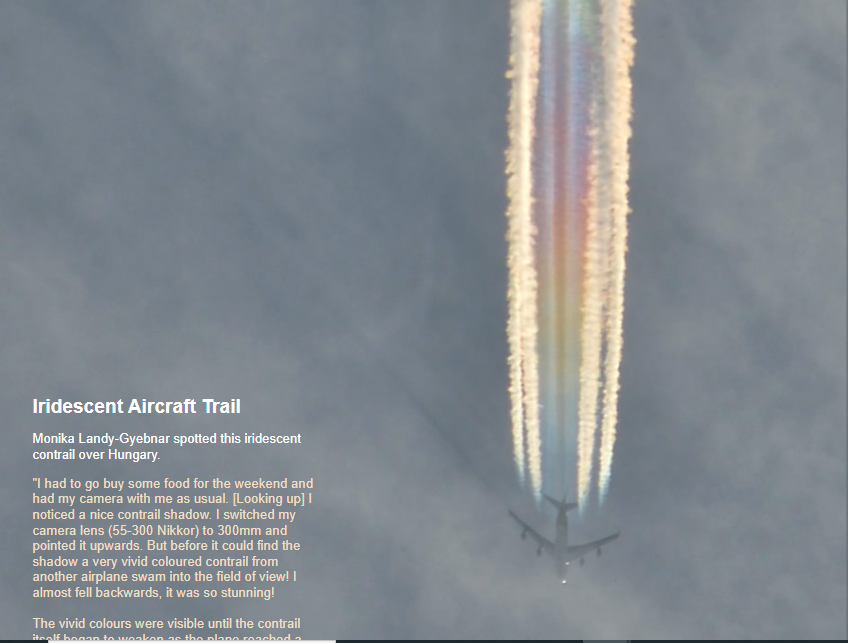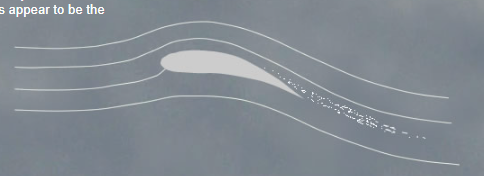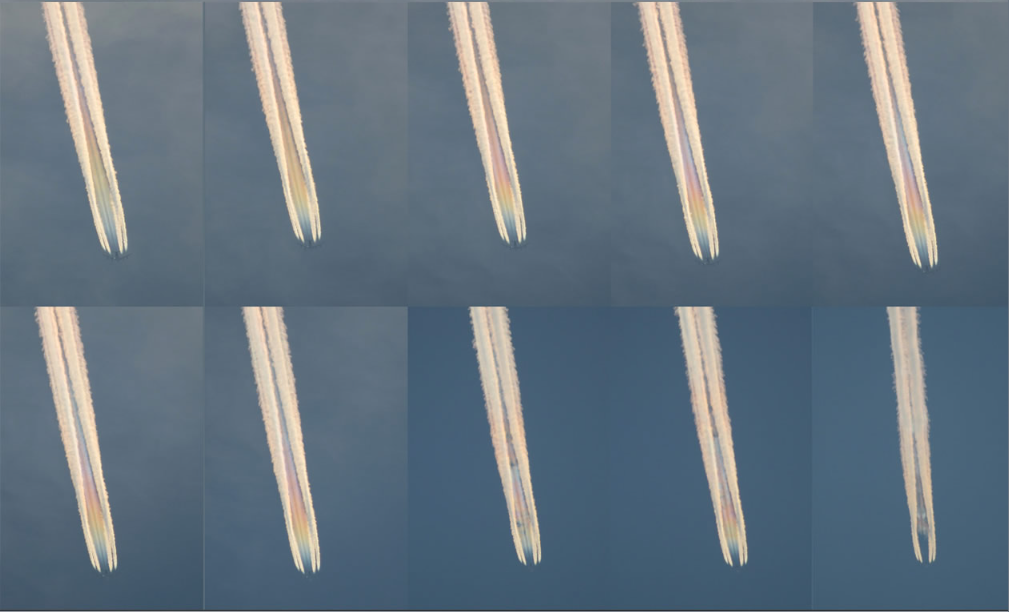OPOD - Contrail Iridescence
OPOD - Contrail Iridescence: A Phenomenon of Vibrant Colors in the Sky
Have you ever looked up at the sky and witnessed a stunning display of vibrant colors within an aircraft contrail? Monika Landy-Gyebnar, a keen observer from Hungary, captured such a mesmerizing sight. While on her way to buy groceries, she noticed a captivating contrail shadow and quickly adjusted her camera lens to capture it. However, before she could focus on the shadow, another airplane passed by, leaving behind a vividly colored contrail that took her breath away.
The iridescent colors within the contrail remained visible until the trail began to weaken as the plane transitioned into a less humid air mass. Monika managed to document the changing appearance of the contrail as it developed gaps due to decreasing humidity. Soon after her last picture, the contrail dissipated completely, leaving the plane to fly without a trail. Additionally, Monika noticed faint shadows cast by the aircraft across the humid air.
Curiosity piqued, Monika decided to investigate further and discovered that the plane responsible for this enchanting spectacle was a Boeing 747 cargo plane operated by Singapore Airlines. It was en route from Dallas to Brussels, flying at an altitude of 10,058 meters (33,000 feet) and cruising at a speed of 883 km/h (550 mph).
Now let's delve into the science behind this fascinating phenomenon. Aircraft contrails are formed through two main sources: water droplets condensed from water vapor generated by the engines and water vapor already present in the air that condenses onto droplets due to airflow over the aircraft's fuselage and wings. In Monika's images, the opaque engine trails dominate the scene.
The iridescence observed within the contrail is caused by individual water droplets diffracting sunlight. When these droplets are of similar size, they all diffract their colored light in the same direction, making the colors visible to us. Typically, droplets of similar sizes result from specific events such as the passage of an aircraft, airflow through a lenticular cloud, the formation of a banner cloud, or freshly formed fog.
It is worth noting that this article has been automatically converted from the old website and may not appear as intended. You can find the original article here.
To summarize the captivating phenomenon of contrail iridescence:
- Contrail iridescence is characterized by vibrant colors observed within an aircraft contrail.
- Monika Landy-Gyebnar captured a stunning example of contrail iridescence over Hungary.
- The colors within the contrail were visible until the trail weakened due to decreasing humidity.
- Faint shadows cast by the aircraft were also visible across the humid air.
- The contrail was produced by a Boeing 747 cargo plane of Singapore Airlines flying from Dallas to Brussels.
- Aircraft contrails have two sources: water droplets condensed from water vapor generated by the engines and water vapor already present in the air that condenses onto droplets due to airflow over the aircraft's fuselage and wings.
- The iridescent colors within the contrail are caused by individual water droplets diffracting sunlight.
- Droplets of similar sizes, resulting from specific events, produce the iridescence.
- Contrail iridescence is a captivating natural phenomenon that adds a touch of magic to our skies.
Next time you find yourself gazing at the sky, keep an eye out for these mesmerizing displays of contrail iridescence. It's nature's way of reminding us of the beauty that surrounds us, even in the most unexpected places.

Iridescent Aircraft Trail
Monika Landy-Gyebnar spotted this iridescent contrail over Hungary.
"I had to go buy some food for the weekend and had my camera with me as usual. .Looking up. I noticed a nice contrail shadow. I switched my camera lens (55-300 Nikkor) to 300mm and pointed it upwards. But before it could find the shadow a very vivid coloured contrail from another airplane swam into the field of view! I almost fell backwards, it was so stunning!
The vivid colours were visible until the contrail itself began to weaken as the plane reached a less humid air mass. The sequence of images .below. shows how the trail changed and developed gaps as the humidity decreased. Very soon after the last pic the contrail formation stopped and the plane flew without a trail.
You can also see some faint shadow cast by the plane across the humid air.
Back home I checked flightradar24.com for the details of the plane. It was a Boeing 747 cargo plane of Singapore Airlines flying east from Dallas and Brussels at 10,058m .33,000ft. high and 883 km/h .550mph.."

Aircraft contrails have two sources. The major one is water droplets condensed from water vapour generated in the engines. Combustion of aviation fuel gives water vapour, carbon dioxide and traces of NOx and soot. Opaque engine trails are prominent in Monika�s images. The second generator is water vapour already in the air condensed to droplets by airflow over the fuselage and wings. Air passing over the top of wings or convex fuselage sections travels faster, expands and cools. Sometimes, if the air is sufficiently humid, water vapour then condenses out into a fine droplet mist. These airflow droplets appear to be the source of the iridescence in Monika�s trail.
The iridescent colours are produced by individual water droplets diffracting sunlight. When the droplets are locally of similar size they all diffract their coloured light into the same direction and so colours become evident to us. Similar sized droplets usually come from a similar life history, the passage of an aircraft, airflow through a lenticular cloud, a banner cloud or freshly formed fog.

Note: this article has been automatically converted from the old site and may not appear as intended. You can find the original article here.
Reference Atmospheric Optics
If you use any of the definitions, information, or data presented on Atmospheric Optics, please copy the link or reference below to properly credit us as the reference source. Thank you!
-
<a href="https://atoptics.co.uk/blog/opod-contrail-iridescence/">OPOD - Contrail Iridescence</a>
-
"OPOD - Contrail Iridescence". Atmospheric Optics. Accessed on December 22, 2024. https://atoptics.co.uk/blog/opod-contrail-iridescence/.
-
"OPOD - Contrail Iridescence". Atmospheric Optics, https://atoptics.co.uk/blog/opod-contrail-iridescence/. Accessed 22 December, 2024
-
OPOD - Contrail Iridescence. Atmospheric Optics. Retrieved from https://atoptics.co.uk/blog/opod-contrail-iridescence/.